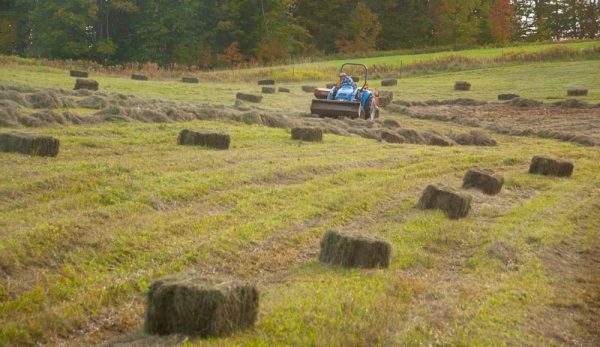
There’s no shortage of specialized equipment available for producing small square hay bales. Bale kickers, basket wagons, bale accumulators and other innovations can save a lot of time and labor.
Of course, not every hobby farmer can afford a complete suite of hay baling equipment. A less specialized operation might involve a tractor pulling a baler and a hay wagon, with a couple of workers riding along to stack the bales as they drop onto the wagon.
But wait—there’s an even simpler approach. Hay can be baled with nothing more than a tractor and a baler if you’re willing to drop the bales straight onto the field for manual pickup later on.
As with anything, there are pros and cons to this strategy. Let’s explore some of the benefits and downsides to letting the small square bales fall where they may.
Read more: We put together some tips for effectively stacking your square hay bales.
Pros
- You don’t need any extra equipment! If you’re baling a small amount of hay and can’t rationalize the cost of specialized equipment or hired help, it’s hard to beat the inexpensive simplicity of dropping the bales out the back of the baler, one by one, to pick up later.
- It’s a one-person operation! The driver of the tractor can theoretically bale the field, come back with a wagon, and pick up the bales without any assistance. It’s more work, true, but if help is in short demand, this approach is an alternative to having a couple of stackers riding a hay wagon behind the baler.
- Less strain on your tractor! If you’re concerned your tractor isn’t strong enough to simultaneously bale hay and pull extra equipment, reducing the load to just a baler will give your tractor a break.
- It can be safer! If fields are sloping or bumpy, dropping the bales is preferable to having a stacking crew riding a hay wagon behind the baler.
- It’s scenic! A freshly-baled field dotted with hay bales is an iconic image worthy of promotion on social media, if you run accounts for your farm.
Read more: How many horsepower do you really need in a tractor?
Cons
- Dropping bales on the field and picking them up later requires a lot more time, particularly if you’re working with a small crew. It’s not hard to double the amount of time you spend on a field this way.
- There’s more labor involved, particularly when compared to automated methods of handling bales. Once they’re on the ground, you have to pick them back up again, which can grow tiring if you’re manually loading hundreds of 50-pound small squares.
- You risk distorting or breaking bales as they fall from the baler to the ground, particularly if you’re producing light, fluffy bales for easy handling. Any bales too misshapen for effective handling will have to be cut open and spread back out to be baled again.
- The longer the bales sit on the field, the greater the chance of something going awry. A sudden summer rainstorm could unexpectedly soak the bales. Or dew could settle on the bales as evening falls, dampening them unnecessarily.
In the end, there’s no right or wrong answer when pondering whether to drop small square bales as you bale them. There are pros and cons on each side of the equation, and whether you drop them or not depends on many interrelated factors, including the specifics of each field you harvest.
What approach do you employ when producing small square bales?




